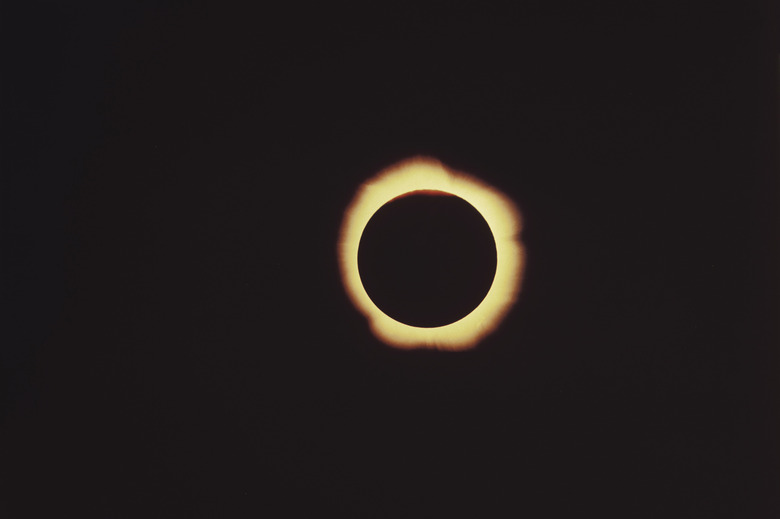What Is The Ring Of Light Around The Moon When There Is A Solar Eclipse?
If you're at the right place at the right time, you might witness a total solar eclipse. During this dramatic event, the moon blocks out the light of the sun to observers on Earth. As the moon covers the sun, rings of light appear from the corona, which appears at the edge of the sun's disk. Careful observers will be able to see the changes in this light during the course of the eclipse.
The Corona
The Corona
At totality, a crown of glowing light shines around the moon. This light comes from the sun's outermost region, its corona. Occasionally, red areas of light dot the corona. This event is hydrogen gas, as it travels along loops of the sun's magnetic field caused by the activity of sunspots.
First and Second Contact
First and Second Contact
A total eclipse occurs when the moon is in exact alignment between the sun and the earth. During first contact, the moon moves in front of the sun, and the sun changes from a bright, round orb to a crescent. At second contact, the moon covers the sun, and a faint strip of sunlight is visible at the edge of the moon. This strip is caused by the many craters, valleys and mountains that give the moon a rough surface. This strip of light also appears at third contact, when the moon begins to move out of the path of the sun.
Baily's Beads
Baily's Beads
Following second contact, bright beads of light appear at the edge of the moon. Called Baily's beads, these dots of lights, like the light strip seen in second contact, are caused by the sun's light peeking through the moon's rough surface. Baily's beads occur at only one edge of the moon; the glow of the sun's corona. appears at the other edge.
Diamond Ring & Chromosphere
Diamond Ring & Chromosphere
Just before totality, some of the sun's light still peeks past the moon, while the sun's corona begins to form more fully around the moon. At this point, a bright spot of light appears at one edge of the moon. With a thin corona band and the moon's dark circle, it looks like a diamond ring hanging in the sky. Just after the diamond ring appears, watch for a thin strip of red light around the moon. This is the sun's chromosphere.
Ring of Fire
Ring of Fire
In a total eclipse, the moon totally covers the surface of the sun. When the moon is at its farthest point from Earth, it can pass in front of the sun but not cover the sun entirely. This event is called an annular eclipse. At the peak of an annular eclipse, a ring of sunlight is still visible behind the moon. The ring glows red, yellow and orange, giving it the name Ring of Fire.
Cite This Article
MLA
Painter, Tammie. "What Is The Ring Of Light Around The Moon When There Is A Solar Eclipse?" sciencing.com, https://www.sciencing.com/ring-light-around-moon-there-solar-eclipse-2514/. 9 March 2018.
APA
Painter, Tammie. (2018, March 9). What Is The Ring Of Light Around The Moon When There Is A Solar Eclipse?. sciencing.com. Retrieved from https://www.sciencing.com/ring-light-around-moon-there-solar-eclipse-2514/
Chicago
Painter, Tammie. What Is The Ring Of Light Around The Moon When There Is A Solar Eclipse? last modified March 24, 2022. https://www.sciencing.com/ring-light-around-moon-there-solar-eclipse-2514/
